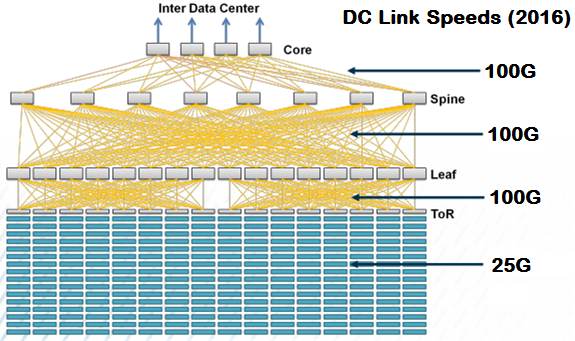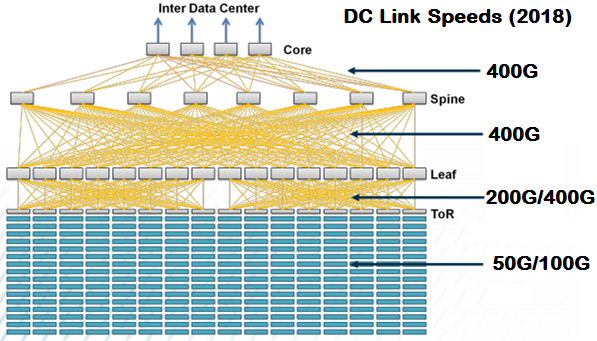From 100G to 800G: The Road to Better, Faster, Cheaper Ethernet
Global IP traffic has been increasing rapidly in the enterprise and consumer segments, driven by growing numbers of Internet users, as well as growing numbers of connected devices that provide faster wireless and fixed broadband access, high-quality video streaming and social networking capabilities.
Data centers are being built globally to support computing, storage and content delivery services for enterprise and consumer users. With higher operation efficiency (CPU usage), higher scalability, lower costs and lower power consumption per workload, cloud data centers will process 92% of overall data center workloads by 2020; the remaining 8% of the workload will be processed by traditional data centers.
According to the Cisco Global Cloud Index 2015-2020, hyperscale data centers will grow from 259 in 2015 to 485 by 2020, representing 47% of all installed data center servers.

Source: Cisco
Global annual data center traffic will grow from 6.5 ZB (zettabytes) in 2016 to 15.3 ZB by 2020. The majority of traffic will be generated in cloud data centers; most traffic will occur within the data center.
When it comes to supporting cloud business growth, higher performance and more competitive services for the enterprise (computing and collaboration) and consumers (video streaming and social networking), common cloud data center challenges include:
- Cost efficiency
- Port density
- Power density
- Product availability
- Reach limit
- Resilience (disaster recovery)
- Sustainability
- System scalability
This is the first in a series of seven blogs that will appear throughout the rest of 2017; in this series, we’ll walk you down the road to 800G Ethernet. Here, we take a close look at Ethernet generations and when they have (or will) come into play.
100G Ethernet: Generation 2017-2018
In 2016, 25G/50G server ports and 100G switch (ToR, leaf, spine and core) ports became commonplace in most hyperscale data centers, replacing previous 10G servers and 40G switches. This migration speed boosted overall system throughput by 2.5 times, with a small incremental cost.
According to the latest Dell’Oro forecast, 100G switch port shipments will outnumber 40G switch port shipments in 2017-2018.

100G Ethernet, however, is only the beginning of what’s yet to come. Consider these facts:
- Overall bandwidth for data centers grows increases by 20 every four years
- Data center power consumption doubles every two years
- Hardware upgrade cycles for data centers occur every two years
In just a few years, we could be facing 800G Ethernet speeds – or faster.
200G/400G Ethernet: Generation 2019-2020
Driven by cloud service providers (CSPs) and Internet service providers, network ASIC (application-specific integrated circuit) vendors and system vendors are working closely to develop next-generation data center computing and networking hardware.
Standards bodies (Optical Internetworking Forum [OIF] and IEEE 802.3) and industry consortiums have accelerated standards and multi-source agreement (MSA) development. At DesignCon in January 2017 and the Optical Fiber Conference in March 2017, many system and connectivity vendors displayed the latest server network interface cards (NICs) and next-generation Ethernet switches with 200G and 400G ports.
According to the leading CSPs, next-generation 200G and 400G Ethernet will deploy starting in 2018, and become mainstream by 2019-2020.
- Server I/O will be 50G and 100G
- ToR, leaf, spine and core switch ports will be 200G or 400G

800G/1.6T Ethernet: Generation 2022-2023
As 200G and 400G Ethernet solutions become mature, the next generation of 800G and 1.6T Ethernet development has already begun.
In December 2016, OIF launched a 100G Serial Electrical Link project: the OIF CEI-112G (common electrical interface) for very-short-reach (VSR) chip-to-module interfaces.
Make sure to subscribe to our blog updates so you can follow this blog series and keep up with road to 800G Ethernet. Yet to come is information about:
- New pluggable form factors
- The evolution of high-speed interface and Ethernet switches
- Layer 0 copper connectivity
- Layer 0 fiber connectivity
- The ubiquity of 100G Ethernet
- Optical fiber cabling migration toward 100G, 200G, 400G and 800G Ethernet
Belden’s complete line of copper and fiber cabling and connectivity solutions will help you prepare the way for 800G Ethernet – and every stop in between. Learn more here.
